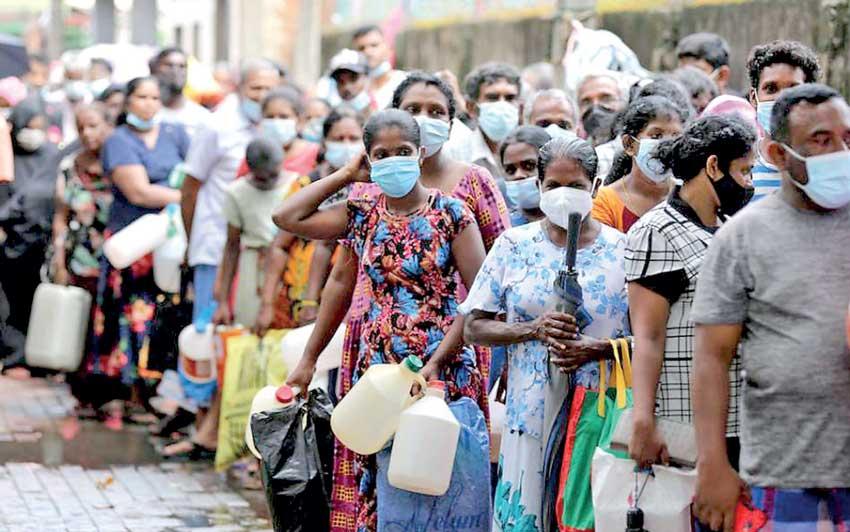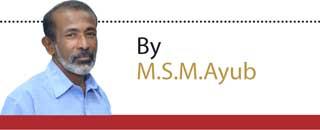02 Jul 2022 - {{hitsCtrl.values.hits}}

People wait to buy kerosene at a gas station amid a fuel shortage in Colombo,
Sri Lanka, 11 April 2022. Chamila Karunarathne, EPA-EFE/file
 Almost all Sri Lankans have reposed or they have been made by their leaders to repose all their hopes on the International Monetary Fund (IMF) for their economic salvation. They have been made to assume that all their problems or at least the current economic catastrophe that have befallen them would be resolved by the IMF.
Almost all Sri Lankans have reposed or they have been made by their leaders to repose all their hopes on the International Monetary Fund (IMF) for their economic salvation. They have been made to assume that all their problems or at least the current economic catastrophe that have befallen them would be resolved by the IMF.
However, it all depends on the programme that would be placed before the IMF by the leaders of the country. It is not yet clear the programme that is to be presented will be something for the temporary bailout from the present crisis or a strong initiative for a long lasting economic revival. In other words, it is not clear if the IMF assistance package would just help Sri Lanka to manage its foreign debt for the moment and consist of a loan or a grant on concessionary terms or make the country economically stand tall.
Sri Lanka has obtained assistance of the World Bank and the IMF in the past. However, that did not help strengthen the country’s economy in such a manner that it could withstand occasional local or international economic hurricanes. It did not at least prevent the country from drifting into a vicious cycle of indebtedness. In fact, it was not the fault of these international financial institutions, but the past governments failed to develop a viable plan to strengthen the economy using the assistance of these institutions.
These institutions tag conditions with their assistance programmes. Those conditions are in most cases unpopular such as pruning state expenditure and boosting state revenue which would be a burden on the people. Politicians who are always concerned about the next election would not prefer these measures. Also countries have the right to decide as to how long they travel with the IMF or the World Bank.
The World Bank on May 22 said “until an adequate macroeconomic policy framework is in place, the World Bank does not plan to offer new financing to Sri Lanka.” Explaining its stance on the matter a statement issued by the Bank said “We are concerned for the people of Sri Lanka and are working in coordination with the IMF and other development partners in advising on appropriate policies to restore economic stability and broad-based growth.” The statement indicates that it is up to the country concerned to plan the economy using the assistance of these institutions.
If our leaders are just planning to temporarily manage the current crisis with the ongoing programme involving the IMF and to continue to borrow from other countries and foreign financial institutions, as in the past that indicates they have not learnt anything from the current disastrous economic meltdown. The crisis that we are undergoing is indeed an eye opener to see where things went wrong in our history and it demands us to turn it into an opportunity to bring the economy to the correct path.
Although politicians in Sri Lanka have been waxing eloquent about developing a manufacturing economy during all elections, they, on the ground closed many factories in the country - paper, cement, sugar, chemicals, tyre, steel and textile among others - that were once flourishing, leaving the country to import almost everything. Have the politicians, both from the ruling party as well as the Opposition and the officialdom taken note of this reality at this difficult juncture and seriously thought of plans to develop the manufacturing and service industries?
For instance, it is a well-known fact that the top bureaucracy in the power sector is not in favour of developing the renewable energy sector and it is the main reason for the current power crisis. This has affected many other sectors including education and transport sectors as well directly or indirectly. The crisis in the transport sector in turn has contributed to so many other issues including food security and cost of living.
The problem and the solution are very clear and the recent statements by the Power and Energy Minister Kanchana Wijesekara indicate that he too is well cognizant of it. If the leaders have learnt a lesson from the current crisis which has made the country an international pauper and is threatening even the very survival of the government, they must have the courage and the commitment to resolve it, if they are not benefitting from it.
Transport is another issue that has to be studied in the face of the current foreign exchange crisis. Professor Amal Kumarage of the Department of Transport and Logistics Management, University of Moratuwa had presented some interesting statistics on the issue in an article published in Daily FT last week. According to him around 76% of our fuel consumption for transport is in passenger travel. 51% of that is used by cars, pick-ups, and SUVs, while 31% is by motorcycles and three-wheelers. Public transport which includes 59,000 buses and private coaches (25,000 private and SLTB buses) carrying half the passengers, consumes only 514 million litres of diesel or 17% of the fuel used for passenger mobility. The railway which transports 5% of passengers takes up the other 1%.
In another paragraph of the article he says; “The train is the most fuel-efficient mode of passenger transport in Sri Lanka. It is 8-9 times more fuel-efficient than an average car, while the bus is 6-7 times more efficient. Amongst private transportation the most efficient is the motorcycle yet it is three times less efficient than a bus. Large private vehicles over 1,500 cc, unless they are hybrid or electric, are the heaviest fuel users. In a fleet of over 1 million passenger cars, pick-ups and SUVs, we have only 5,000 or less electric vehicles and some 200,000 hybrid vehicles. This means over 80% of our cars, pick-ups and SUVs are not fuel efficient. Other passenger vehicles, which make up 4 million, use only diesel or petrol.
Fifty one percent of fuel for over a million passenger cars, pick-ups and SUVs,17 percent for 59,000 buses and private coaches and one percent for trains. Both the problem and the solution lie in these figures. This situation results in massive road congestions in urban areas as well as the resultant loss of millions of man hours and environment pollution. A decent public transport system is the solution. However, this is not in anywhere in the priority list of the politicians and the bureaucracy.
The facts extracted through the grilling of public sector officials by the Committee on Public Enterprises (COPE) of the Parliament these days seem to have drawn the interest of the people, unlike in the past, possibly due to the harrowing effects of the economic crisis. Nonetheless, what is the use? We have been told about malpractices in the public enterprises running into hundreds of billions of rupees by the COPE and Committee on Public Accounts (COPA) of the Parliament for the past several decades, without taking a single culprit to task.
Only if these and hundreds of similar issues are integrated into a macroeconomic plan following the bailout programme by the IMF, we would be able to withstand any future economic storms. Yet, it is not clear if our leaders have learnt any lesson from the past.
27 Nov 2024 24 minute ago
27 Nov 2024 34 minute ago
27 Nov 2024 38 minute ago
27 Nov 2024 56 minute ago
27 Nov 2024 2 hours ago